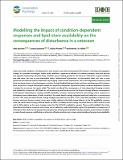Files in this item
Modelling the impact of condition-dependent responses and lipid-store availability on the consequences of disturbance in a cetacean
Item metadata
| dc.contributor.author | Burslem, Alec C. | |
| dc.contributor.author | Isojunno, Saana | |
| dc.contributor.author | Pirotta, Enrico | |
| dc.contributor.author | Miller, Patrick James | |
| dc.date.accessioned | 2022-11-21T13:30:05Z | |
| dc.date.available | 2022-11-21T13:30:05Z | |
| dc.date.issued | 2022-11-30 | |
| dc.identifier | 282096118 | |
| dc.identifier | 72cf83fe-62ef-44b8-b436-90957fed107d | |
| dc.identifier | 85144780087 | |
| dc.identifier | 000886588900001 | |
| dc.identifier.citation | Burslem , A C , Isojunno , S , Pirotta , E & Miller , P J 2022 , ' Modelling the impact of condition-dependent responses and lipid-store availability on the consequences of disturbance in a cetacean ' , Conservation Physiology , vol. 10 , no. 1 , coac069 . https://doi.org/10.1093/conphys/coac069 | en |
| dc.identifier.issn | 2051-1434 | |
| dc.identifier.other | ORCID: /0000-0003-3541-3676/work/123195742 | |
| dc.identifier.other | ORCID: /0000-0001-7591-8391/work/123195873 | |
| dc.identifier.other | ORCID: /0000-0002-2212-2135/work/123196117 | |
| dc.identifier.uri | https://hdl.handle.net/10023/26455 | |
| dc.description | Funding: This work was supported by the United States Office of Naval Research (awards N00014-17-1-2757 and N00014-19-1-2479). | en |
| dc.description.abstract | Lipid-store body condition is fundamental to how animals cope with environmental fluctuations, including anthropogenic change. As it provides an energetic buffer, body condition is expected to influence risk-taking strategies, with both positive and negative relationships between body condition and risk-taking posited in the literature. Individuals in good condition may take more risks due to state-dependent safety (‘ability-based’ explanation), or alternatively fewer risks due to asset protection and reduced need to undertake risky foraging (‘needs-based’ explanation). Such state-dependent responses could drive non-linear impacts of anthropogenic activities through feedback between body condition and behavioural disturbance. Here, we present a simple bioenergetic model that explicitly incorporates hypothetical body condition-dependent response strategies for a cetacean, the sperm whale. The model considered the consequences of state-dependent foraging cessation and availability of wax ester (WE) lipids for calf provisioning and female survival. We found strikingly different consequences of disturbance depending on strategy and WE availability scenarios. Compared with the null strategy, where responses to disturbance were independent of body condition, the needs-based strategy mitigated predicted reductions in provisioning by 10%–13%, while the ability-based strategy exaggerated reductions by 63%–113%. Lower WE availability resulted in more extreme outcomes because energy stores were smaller relative to the daily energy balance. In the 0% availability scenario, while the needs-based strategy reduced deaths by 100%, the ability-based strategy increased them by 335% relative to null and by 56% relative to the same strategy under the 5%–6.7% WE availability scenario. These results highlight that state-dependent disturbance responses and energy store availability could substantially impact the population consequences of disturbance. Our ability to set appropriate precautionary disturbance thresholds therefore requires empirical tests of ability- vs needs-based response modification as a function of body condition and a clearer understanding of energy store availability. | |
| dc.format.extent | 19 | |
| dc.format.extent | 1842429 | |
| dc.language.iso | eng | |
| dc.relation.ispartof | Conservation Physiology | en |
| dc.subject | Body condition | en |
| dc.subject | Population consequences of disturbance | en |
| dc.subject | Sperm whale | en |
| dc.subject | GC Oceanography | en |
| dc.subject | QH301 Biology | en |
| dc.subject | QP Physiology | en |
| dc.subject | DAS | en |
| dc.subject | MCC | en |
| dc.subject.lcc | GC | en |
| dc.subject.lcc | QH301 | en |
| dc.subject.lcc | QP | en |
| dc.title | Modelling the impact of condition-dependent responses and lipid-store availability on the consequences of disturbance in a cetacean | en |
| dc.type | Journal article | en |
| dc.contributor.institution | University of St Andrews. Sea Mammal Research Unit | en |
| dc.contributor.institution | University of St Andrews. School of Biology | en |
| dc.contributor.institution | University of St Andrews. School of Mathematics and Statistics | en |
| dc.contributor.institution | University of St Andrews. Scottish Oceans Institute | en |
| dc.contributor.institution | University of St Andrews. Marine Alliance for Science & Technology Scotland | en |
| dc.contributor.institution | University of St Andrews. Institute of Behavioural and Neural Sciences | en |
| dc.contributor.institution | University of St Andrews. Centre for Social Learning & Cognitive Evolution | en |
| dc.contributor.institution | University of St Andrews. Bioacoustics group | en |
| dc.contributor.institution | University of St Andrews. Centre for Research into Ecological & Environmental Modelling | en |
| dc.identifier.doi | 10.1093/conphys/coac069 | |
| dc.description.status | Peer reviewed | en |
This item appears in the following Collection(s)
Items in the St Andrews Research Repository are protected by copyright, with all rights reserved, unless otherwise indicated.

